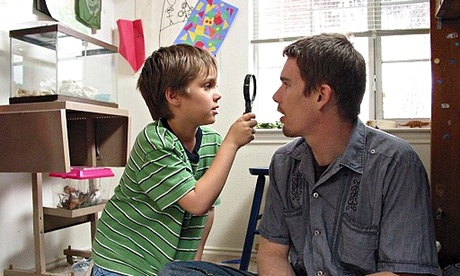
It's unusual for a movie to get 100% positive reviews on the Rotten Tomatoes website, but a new film by Richard Linklater, Boyhood, achieves that distinction. Filmed over 12 years, it shows a boy (and the actor playing the boy) growing from child to teenager amid the swirls and eddies of family life.
As it purports to show that journey with remarkable veracity, I expected my teenage daughter, with whom I saw the film, to give it a rave review. Her response was somewhat different – "Well, that's the most shit film I've ever seen." And I'm sorry to take issue with so many esteemed film critics, but I definitely lean in her direction, although there were one or two lovely moments (such as when Mason, the central character, is required to help re-paint the house when the family moves and poignantly runs the brush over the door frame to eradicate all the pencil marks that have marked his growing up over the years).
Certainly it was a brave project. The trouble with family life is that it really is banal – unless you are actually living it yourself. The profundity of the experiences you share with your children, whether joyful or poignant, are intensely personal – for an outside observer they mean very little.
Linklater makes few concessions to what one might call the genuine requirements of art, that is, to convert the banality of personal experience into something universal that will engage a wider audience. Mason is, for the most part, played blank – presumably to present childhood as a passive centre in an ever moving, dominating, chaotic world. Drama is low key – a birthday party, a graduation – and when it ramps up the scale, it lapses into well-worn tropes. Hence the feckless but loveable father, the abusive stepfather, the hard working, gives-it-all-but-makes-bad-choices mother.
"It's just one cliche after another," complained Rose. The worse cliche of all, she said, was the central teenage character himself – uncommunicative, interior, inarticulate. The parts she enjoyed most were watching him and his sister as children, because in childhood the banal really can be charming to the outside observer. But on the whole, the film, for all its combination of realism and stock characterisation, is like life itself – not much happens and it's a struggle to get through. Perhaps that's the point.
Film-makers and critics alike seem to have a blind spot when it comes to characterisations of teenage life. Tomboy, a French film about a gender-confused girl, got 97% on Rotten Tomatoes. So did We Are the Best!, Lukas Moodysson's hymn to alienated teenage girl punks in Sweden. My reaction was much the same as to Boyhood – too much so-called reality, not enough storytelling nous.
As a novelist, I know that trying to evoke the inner life of an adolescent is one of the most difficult tasks one can undertake. That experience, which we have all been through, seems nevertheless strangely elusive. Perhaps my 20 year old, Jean, has the explanation – "because when you're that age, you're not that deep".
JD Salinger was the greatest exponent of the art of depicting teenage growing pains – and he was successful because he didn't leave his character, Holden Caulfield, as a blank slate, but gave him an inner life that shines through every page of The Catcher in the Rye. Film-makers, robbed of the luxury of the writer's opportunity to write internal dialogue, are often left wanting, and Boyhood is certainly a case in point.
There's also a certain flinching in the film, for all its commitment to vérité. Although Boyhood is not sentimental, it still averts its eyes from the wounds of childhood. It sells itself as honest, but it is only honest in the sense that a photograph, a 2D representation of a 3D world, is honest. In family life, as in all life, the depths are hidden. Holding up a mirror to it is briefly diverting, but it is in itself nothing more than a surface.
• Follow Tim on Twitter @timlottwriter
• This article was amended on 14 July 2014 because an earlier version said the film We Are The Best! was set in Denmark. This has been corrected to say Sweden.

